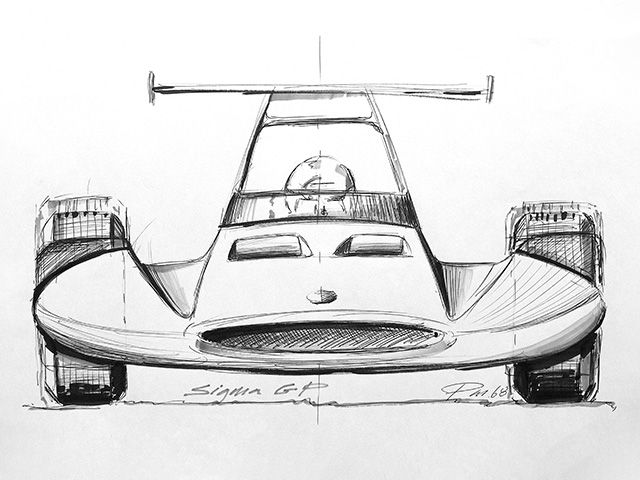“PM1” and “1300”: the Bugattis that never saw the light
- Paolo Martin

- Apr 6, 2023
- 5 min read
Updated: Jun 7, 2023
Directly from the memories of Paolo Martin, the story of two Bugattis that never saw the light. SpeedHolics readers can judge the quality of the Turin-based designer’s design in relation to the EB110 we all know and love
Photos and Drawings courtesy of Paolo Martin Archive

A premise: today, the EB110 is one of the most sought-after models by collectors, selling at figures that have practically doubled in a couple of years. Yet its gestation, and its short life, were not so simple. In-house rivalry, disputes between partners, second thoughts on the design and economic problems affected its development right from the outset. Especially as concerns the bodywork lines and design: in fact, before tasking the architect Benedini (a former designer at the Bugatti factory in Campogalliano, Modena) with the revision of Marcello Gandini’s unsatisfactory design, in 1989 the initial partners (the engineer Paolo Stanzani and the industrialist Romano Artioli) had called in three other stylists in addition to Gandini: Paolo Martin, Giorgetto Giugiaro and Nuccio Bertone. In the end, Gandini’s model was chosen, he had already designed the Lamborghini Miura and Countach with Stanzani. Bertone pulled out of the competition early, while Giugiaro’s proposal was deemed unsuitable. On the other hand, Artioli liked Paolo Martin’s model very much, but for time reasons (Gandini’s model was in a more advanced design phase and the production times were tight) it couldn’t be taken into due consideration. This story is therefore the story of a design that could have led to a different Bugatti EB110 to the one that was built, certainly more innovative and highly original in style terms, but which remained in the book of dreams. Afterwards, Paolo Martin was also asked to design a small sports Bugatti with a 1300 cc central rear engine, but the events that led to the bankruptcy of Bugatti prevented it from being made. So here is the story, the behind-the-scenes and the technical and style solutions, told by Paolo Martin himself.

PM1
If I remember well, I was asked to work on the study and production of a 1:4 scale model of a Bugatti super sports car in late March 1989. That was when I received a visit from Romano Artioli, accompanied by Paolo Stanzani and Dario Trucco who had been put in charge of the bodywork development. They wanted to know how I planned to interpret the theme of a car with advanced characteristics, with a view to potential production. The chassis was the one on which the EB110 was then made.
This project had been commissioned also to Giorgetto Giugiaro and Marcello Gandini, who had already developed their scale 1:1 proposal. And so I interpreted the decision to contact me as the result of Artioli and Stanzani not being fully satisfied of the work done by our two famous colleagues.
I threw myself into it, and in May that year (two months after the initial request) I submitted a 1:4 scale model made entirely by me on the basis of the Bugatti EB 110 technical drawings I had received at the end of March. I should say that my final design was not an exercise in style but rather a proposal suited to the taste of the time, a project that considered all the ergonomic demands, the regulations in force in the various countries, the realistic feasibility and the construction economy: so a project ready for production.


In fact, I remember that when Artioli saw the model he was enthusiastic, but said he was sorry that he couldn’t take it into consideration as the development programmes of the Bugatti revival were too tight to allow second thoughts. It was a shame, because I had also designed the internal set-up, with lots of original ideas.
The design philosophy was basically that of creating two separate sections between the traction area and the passenger compartment, which had a light shape ideally detached from the body. As with my other works, this design wasn’t inspired by anything. Initially it was a two-seater coupé, then transformed into a single-seater when, after Bugatti’s refusal, a small Japanese manufacturer asked me to adapt the design to their needs (they wanted to repropose the Cobra brand). But as often happens, this idea also came to nothing.
The passenger compartment consisted of a tetragonal capsule, in which the steering wheel, with no steering column, was replaced by two synchronous flywheels located on the arm rests, offering a more ergonomic drive. The driver entered the car by sliding back part of the roof and lifting the windscreen. In addition, the car was transformed into a ‘barchetta’ by removing the mobile part. As regards the safety belt, the driver had a four-point seat belt incorporating an abdominal airbag which expanded outwards and one in the front seat cushion to reduce the impact of the chest on the knees.

It was a simple and ergonomic design to produce. Today the style may seem a little dated, with certain aerodynamic appendages that would no longer be fashionable, but we have to remember that it is a design from 34 years ago.
After the disappointments, I began to develop the idea independently, using extremely simple resources (wood, resins, plenty of elbow grease and self-confidence) and completed the job, making a real 1:1 scale model of my idea, which I called the PM1. A project that complied with the dimensions and sizes of the EB110 that many will have seen at the Turin Motor Show in 2005, or at the Essen Motor Show in 2017 or at the Turin Car Museum in 2020.

BUGATTI 1300
Some time after the decision not to produce my idea of the EB110, in 1990, Artioli asked me to design a small sports coupé. Bugatti wanted to make the model on a chassis and with a 1300 cc Suzuki engine, located in the rear central part, like the Lancia Beta Montecarlo.
We worked on the designs and the 1:4 scale model, which was also tested in the wind tunnel with good results. At that time, small sports coupés were all the rage, and many manufacturers saw potential future developments in this segment. Unfortunately, this project also remained only an idea, as in the meantime Bugatti had gone bust.


In this case I must say I didn’t express myself to my full potential. Nothing special came out of it in style terms, other than one more car. I wasn’t enthusiastic about the project right from the start.
When you start off with ideas that are not focused, things don’t come out well. You start to have constraints, you start to think, everyone chips in with their ideas. I did it, but wasn’t entirely convinced. I had realised that it was an attempt with no concrete potential for production, and so I didn’t make much effort.

In my idea, there was some very minor formal research, and some rather fashionable appendices. The interesting thing was the solution for the tilt-up door, which allowed you to get out of the passenger compartment despite the little side space, as the doors of the coupé are conventionally longer.





















Comments